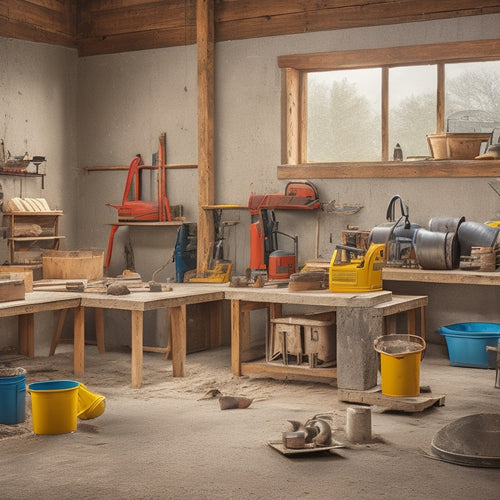
Best Tools for Smoothing Concrete Surfaces
Share
When smoothing concrete surfaces, you'll want to choose the right tool for the job to achieve a flawless finish. Hand tampers offer control and precision, while power tampers provide efficiency and speed. Compaction tools, like bull floats and tamping rakes, help achieve uniform compaction. Vibratory tamping tools and concrete finishing trowels are also valuable additions to your toolkit. Consider factors like handle materials, plate thickness, and surface finish to guarantee durability. With so many options available, selecting the best tool for your project can be intimidating, but understanding the key features and considerations will help you make an informed decision that sets you up for success.
Key Takeaways
• Choose the right tamper type: hand, power, or compaction tools, considering project size, budget, and desired level of precision.
• Select durable tools with ergonomic handles, suitable plate thickness, and smooth surface finishes to prevent scratching concrete surfaces.
• Consider the material's compressive strength, surface hardness, and impact resistance when selecting a tamper for optimal performance and longevity.
• Ergonomic design, grip texture, and comfort fit are crucial for reducing fatigue, strain, and accidents during extended use.
• The right tamper edge shape, size, and material can significantly impact the quality of the finished concrete surface, so choose wisely.
Top Rated Tamping Tools for DIY Projects
When tackling a DIY concrete project, you'll need a reliable tamping tool to secure a smooth, even finish. The top-rated options for this task include bull floats, hand tampers, and power tampers. These tools will help you achieve the desired surface texture and prevent defects like unevenness, honeycombing, or scaling.
To guarantee a successful project, it's vital to master proper tamping techniques, such as applying gentle to moderate pressure, working in small sections, and maintaining a consistent pattern. Effective project planning is also important, as it allows you to allocate sufficient time for tamping and finishing. By doing so, you can minimize the risk of errors and secure a high-quality finish.
Remember to always follow safety guidelines when working with concrete, including wearing protective gear, such as gloves, safety glasses, and a dust mask. With the right tools and techniques, you'll be well on your way to achieving a professional-looking finish that's both durable and aesthetically pleasing.
Buying Guide for Tamping Tools
Buying Guide for Tamping Tools
Your tamping tool selection should be guided by factors such as the size and scope of your project, the type of concrete you're working with, and your personal comfort level with vibration and weight. As you evaluate different tamping tools, consider the following key factors:
-
Weight and ergonomics: Look for tools that fit comfortably in your hand, with a balanced weight that reduces fatigue and strain.
-
Vibration control: If you're concerned about vibration exposure, choose tools with built-in vibration reduction features or ergonomic grips that minimize hand-arm vibration.
-
Plate size and shape: Select a tool with a plate size and shape that matches your project's specific surface preparation needs.
-
Power source: Decide between electric, pneumatic, or manual tools based on your power requirements and availability.
-
Tamping techniques and surface preparation: Consider the specific tamping techniques and surface preparation requirements for your project, and choose a tool that can effectively meet those needs.
Types of Concrete Tamping Tools
As you begin selecting the right tamping tools for your concrete project, you'll need to evaluate the specific requirements of your job site and the type of finish you're aiming for.
You'll likely find yourself choosing between hand tamper options, which offer more control and precision, or power tamper uses, which provide increased efficiency and speed.
Hand Tamper Options
You'll find hand tampers in various shapes, sizes, and materials, each designed to address specific concrete smoothing challenges. When choosing a hand tamper, consider the type of concrete you're working with, the surface finish desired, and the level of compaction required.
Here are some key benefits and considerations for hand tamper usage:
-
Versatility: Hand tampers can be used for a variety of applications, from small repairs to large-scale construction projects.
-
Cost-effective: Hand tampers are often less expensive than power tampers, making them a great option for smaller projects or tight budgets.
-
Easy maintenance: Regular cleaning and lubrication can extend the life of your hand tamper, reducing the need for frequent replacements.
-
Improved control: Hand tampers provide more control over the compaction process, allowing for a more precise finish.
-
Safety: Hand tampers reduce the risk of accidents associated with power tools, making them a safer choice for workers.
Power Tamper Uses
When you need to tackle larger concrete projects or require more efficient compaction, power tampers become the go-to tools, offering enhanced productivity and precision. These powerful machines are designed to handle heavy-duty applications, making them ideal for large-scale construction projects, roadwork, and industrial flooring. With power tamper applications, you can achieve uniform compaction, reduce labor costs, and increase overall efficiency.
Power tampers boast advanced features that set them apart from hand tampers. They typically come equipped with heavy-duty engines, robust frames, and high-frequency vibrating plates. These features enable you to compact concrete quickly and effectively, even in challenging environments.
Some power tampers also include adjustable handlebars, providing added comfort and control during extended use. Additionally, many modern power tampers incorporate safety features, such as ergonomic grips and protective guards, to minimize operator fatigue and risk of injury.
Tamping Tool Materials and Durability
When selecting a tamping tool, you'll want to take into account the materials used in its construction, as they greatly impact its performance and lifespan.
You'll need to evaluate the handle material, which can be wood, fiberglass, or steel, and the thickness of the tamping plate, which typically ranges from 1/4 to 1 inch.
Tool Handle Materials
Your tamping tool's handle material plays an essential role in its overall durability and performance, as it affects your grip, comfort, and control during the concrete smoothing process. A well-designed handle can reduce fatigue and improve your overall experience.
When selecting a tamping tool, consider the following handle materials for peak performance and safety:
-
Fiberglass handles: Lightweight and durable, offering excellent grip and resistance to corrosion.
-
Aluminum handles: Strong and corrosion-resistant, with a comfortable grip and reduced fatigue.
-
Wooden handles: Traditional and ergonomic, providing a comfortable grip and natural feel.
-
Composite handles: Combining materials for enhanced durability, grip, and resistance to corrosion.
-
Ergonomic handles: Designed for comfort and reduced fatigue, with contours that fit your hand naturally.
These handle materials offer varying degrees of handle ergonomics and material longevity, ensuring a comfortable and secure grip during extended use.
Tamping Plate Thickness
Selecting the ideal tamping plate thickness is crucial, as it directly impacts the tool's durability, performance, and ability to effectively smooth concrete surfaces.
You need to take into account the tamping plate dimensions, as a thicker plate can provide more stability and pressure, but may be heavier and more difficult to maneuver. On the other hand, a thinner plate may be lighter and easier to use, but may not provide enough pressure to effectively compact the concrete.
When choosing a tamping plate, you should also take into account the tamping plate materials. Steel and aluminum are popular options, as they're durable and can withstand the rigors of concrete finishing.
However, steel plates may be heavier and more prone to rust, while aluminum plates may be lighter but more prone to bending.
You should also take into account the plate's surface finish, as a smooth finish can help prevent scratching the concrete surface.
Durability Testing Methods
You'll want to put tamping tool materials through their paces with rigorous durability testing to confirm they can withstand the punishing demands of concrete finishing. This is vital to guarantee the tools can maintain their performance and integrity over time, even when exposed to harsh conditions and heavy use.
To evaluate the durability of tamping tool materials, you'll need to conduct various tests. These include:
-
Compressive strength testing: to determine the material's ability to withstand crushing forces
-
Surface hardness testing: to assess the material's resistance to wear and abrasion
-
Impact resistance testing: to evaluate the material's ability to absorb shocks and impacts
-
Corrosion resistance testing: to determine the material's resistance to rust and degradation
-
Fatigue testing: to assess the material's performance under repeated stress and strain
Handle and Grip Design Considerations
The handle and grip design of a concrete smoothing tool considerably impacts the user's ability to maintain control and precision during the finishing process.
As you work with concrete, you need a tool that fits comfortably in your hand, allowing you to focus on the task at hand. Look for an ergonomic design that reduces fatigue and strain, ensuring you can work for extended periods without discomfort.
The grip texture is also vital, as it affects the tool's overall grip security. A textured grip with strategically placed ridges or bumps will provide a secure hold, even when your hands are wet or gloved. This is particularly important when working with wet concrete, where a loss of grip can lead to accidents or injuries.
Tamping Edge Shapes and Sizes
As you move on to the concrete smoothing process, the shape and size of the tamping edge become critical factors in achieving a uniform, even finish. A well-designed tamping edge can make all the difference in creating a smooth, professional-looking surface. You'll want to take into account the type of concrete you're working with, as well as the desired finish, when selecting the right tamping edge shape and size.
Here are some key considerations to keep in mind:
-
Tamping edge angles: A 30- to 40-degree angle is ideal for most concrete smoothing applications, allowing for efficient tamping and minimal scratching.
-
Edge radius: A rounded edge radius helps to prevent scratching and promotes a smooth finish.
-
Edge width: A wider edge (1-2 inches) is better suited for larger, flatter areas, while a narrower edge (1/2-1 inch) is more suitable for smaller, tighter spaces.
-
Tamping edge materials: Choose from durable materials like steel, aluminum, or polyurethane, each with its own strengths and weaknesses.
-
Tamping surface patterns: Reflect on the pattern of the tamping surface, such as a flat or curved surface, to achieve the desired finish.
Tool Weight and Balance Factors
When selecting a concrete smoothing tool, its weight and balance become important factors in maintaining control and reducing fatigue during extended use. You'll want to evaluate tools with ideal weight distribution, ensuring that the weight is evenly dispersed throughout the tool, making it easier to maneuver and control. A well-balanced tool reduces the strain on your muscles, allowing you to work for longer periods without exhaustion.
Balance techniques are also vital in concrete smoothing. Look for tools with ergonomic handles that fit comfortably in your hand, providing a secure grip and reducing the risk of accidents. The handle's length and material should also be taken into account, as they impact the overall balance and weight distribution of the tool.
A tool with a well-designed handle and balanced weight distribution will enable you to maintain a consistent pace and achieve a smooth finish. By prioritizing weight and balance factors, you'll be able to work efficiently and safely, producing high-quality results with minimal fatigue.
Budget-Friendly Tamping Tool Options
You'll find that investing in a high-quality tamping tool doesn't have to break the bank, with budget-friendly options available that still deliver professional-grade results.
As you explore the market, keep in mind that effective tamping techniques require the right tool for the job. Fortunately, you don't have to sacrifice quality for affordability.
Here are some budget-friendly tamping tool options to take into account:
-
Hand tamper: A compact, lightweight option ideal for small to medium-sized projects.
-
Bull float: A versatile tool that can be used for both tamping and finishing concrete surfaces.
-
Tamping rake: A long-handled tool with a flat, wide head for efficient tamping and leveling.
-
Vibratory tamping tool: A cost-effective alternative to electric or pneumatic tampers, offering improved compaction and reduced fatigue.
-
Concrete finishing trowel: A multi-purpose tool that can be used for tamping, finishing, and edging concrete surfaces.
When selecting a budget-friendly tamping tool, prioritize durability, ergonomic design, and ease of use to guarantee safe and effective tamping techniques.
Frequently Asked Questions
Can I Use a Tamping Tool on Freshly Poured Concrete?
When you're working with freshly poured concrete, you're probably wondering if you can use a tamping tool to get the job done. The answer is yes, but you need to be cautious.
Use proper tamping techniques to avoid over-working the concrete, which can lead to surface defects. As you're finishing the concrete, make certain to use gentle, even strokes to prevent damage.
Do I Need to Clean My Tamping Tool After Each Use?
As you wipe the sweat from your brow, you glance down at your trusty tamping tool, now caked with dried concrete.
Don't let it become a breeding ground for bacteria and debris! You need to clean it after each use to maintain its effectiveness and prevent damage.
Remove excess concrete with a wire brush, then sanitize with a mixture of soap and water.
Regular tamping tool maintenance is essential for peak performance and your safety on the job site.
Can Tamping Tools Be Used on Non-Concrete Surfaces?
You're wondering if tamping tools can be used on non-concrete surfaces. The answer is, it depends.
While tamping tools are designed for concrete, you can use them on other materials with caution. Look for tamping tool alternatives made from materials like stainless steel or fiberglass, which can withstand varying surfaces.
However, always check the manufacturer's guidelines and take necessary safety precautions to avoid damage or injury.
Be sure to inspect the tool's condition and clean it thoroughly after each use to guarantee peak performance.
Are Tamping Tools Suitable for Commercial Construction Projects?
When tackling commercial construction projects, you'll want to evaluate the suitability of tamping tools.
These tools offer advantages like efficient compaction and uniform surface finish.
However, for commercial projects, you must also weigh considerations like project scale, timeline, and labor requirements.
Make certain you're using the right tamping tool for the job to avoid delays and guarantee worker safety.
Assess your project's specific needs and choose a tool that meets those demands.
Can I Make My Own DIY Tamping Tool at Home?
You're considering creating your own DIY tamping tool at home. While it's possible, be cautious: homemade tamping alternatives may not meet commercial standards.
Before attempting DIY tamping techniques, guarantee you understand the risks and necessary safety precautions.
Improperly crafted tools can lead to uneven surfaces, injuries, or even damage to surrounding structures.
It's vital to prioritize safety and consider the potential consequences of subpar DIY tools.
Conclusion
As you've seen, the right tamping tool can make all the difference in achieving a smooth, even concrete surface.
But will you be willing to settle for anything less than perfection?
With the top-rated tamping tools reviewed here, you can guarantee a professional-grade finish that'll leave a lasting impression.
Whether you're a DIY enthusiast or a seasoned pro, investing in a high-quality tamping tool is a no-brainer – your concrete surfaces will thank you.
Related Posts
-

What Tools to Rent for a Concrete Home Reno
When tackling a concrete home renovation, you'll need to rent a variety of specialized tools to get the job done. For...
-

Why You Need These Concrete Overlay Tools
When tackling a concrete overlay project, you need the right tools to achieve a flawless finish and avoid costly mist...
-

10 Best Tools for Sealed Concrete Finishing Success
When it comes to sealed concrete finishing success, you need a robust arsenal of specialized tools. Start with essent...


